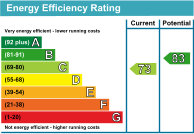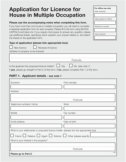Preparation to Let
We know that getting your property ready for tenants can be a big task. Here is a list of the main things you will need to ensure are taken care of. We are here to help. Lean on us, if you need to.
Energy Performance Certificates
 All rental properties in England require an Energy Performance Certificate within 7 days of marketing.
All rental properties in England require an Energy Performance Certificate within 7 days of marketing.
We can arrange one for you if needed at a cost of £90 inc. VAT. Minimum Energy Efficiency Standards also apply, which mean properties with an EPC rating of F or G may not be let unless a valid exemption is obtained.
For more information, click here
Safety Certificates
 Before the tenancy can start we will need to have copies of all relevant safety certificates and they must all be satisfactory and correctly filled in (you would be surprised how many we get that are not!).
Before the tenancy can start we will need to have copies of all relevant safety certificates and they must all be satisfactory and correctly filled in (you would be surprised how many we get that are not!).
Electrical Safety
 Every rental property now requires an Electrical Installation Safety Certificate before it can be let. A copy must be provided to the tenants before the tenancy starts and if and work is needed (other than C3 recommendations) these must be completed within 28 days with evidence provided to the tenants within another 28 days of the completion of the work.
Every rental property now requires an Electrical Installation Safety Certificate before it can be let. A copy must be provided to the tenants before the tenancy starts and if and work is needed (other than C3 recommendations) these must be completed within 28 days with evidence provided to the tenants within another 28 days of the completion of the work.
Electrical Appliances
Any Electrical Appliances in the property must be safe for use and have a manual provided so the tenants know how to operate them correctly. We strongly advise PAT testing as this is the best way to know an appliance is safe and it gives you a written record of the testing undertaken and therefore a defence if needed at a later date in a worst-case-scenario.
 If the property has gas we will need a valid Landlords' Gas Safety Record before the tenancy can begin.
If the property has gas we will need a valid Landlords' Gas Safety Record before the tenancy can begin.
Smoke Alarms & Carbon Monoxide Detectors
 All rental properties are required to have a working smoke alarm on each level of the property that has a habitable room at the commencement of the tenancy and a working carbon monoxide detector in each room containing a solid fuelburning appliance (e.g., a working fireplace or log-burner). Detectors should be fitted as per the manufacturer's instructions - this will usually be to the ceiling for smoke alarms.
All rental properties are required to have a working smoke alarm on each level of the property that has a habitable room at the commencement of the tenancy and a working carbon monoxide detector in each room containing a solid fuelburning appliance (e.g., a working fireplace or log-burner). Detectors should be fitted as per the manufacturer's instructions - this will usually be to the ceiling for smoke alarms.
Health & Safety Considerations
There are many things to consider with health and safety and providing a safe environment for your tenants to live in. Whilst it is very difficult to ensure a totally riskfree environment, there are things that can be done to lower the risk and therefore potential liability. The most common things we see that can be an issue are:
Ponds or other Water Features
 Ideally ponds or other water features should be covered or have a small fence to lower the risk of injury or drowning (!) - of course to completely remove the risk you could consider removing the water feature. The main thing to be aware of is not necessarily the water feature itself, as in isolation it isn't dangerous, but the area surrounding it can contribute to the risk, e.g., uneven ground, loose or broken paving will need to be made safe.
Ideally ponds or other water features should be covered or have a small fence to lower the risk of injury or drowning (!) - of course to completely remove the risk you could consider removing the water feature. The main thing to be aware of is not necessarily the water feature itself, as in isolation it isn't dangerous, but the area surrounding it can contribute to the risk, e.g., uneven ground, loose or broken paving will need to be made safe.
Handrails
 Any sets of stairs will need a handrail (at least one) to help prevent falling. This can apply externally also if there are any significant changes of level where someone could fall. Stairs and bannisters will need to have closelyspaced spindles (to prevent small children from falling) and any with horizontal spindles should be covered (as children can climb and fall from them).
Any sets of stairs will need a handrail (at least one) to help prevent falling. This can apply externally also if there are any significant changes of level where someone could fall. Stairs and bannisters will need to have closelyspaced spindles (to prevent small children from falling) and any with horizontal spindles should be covered (as children can climb and fall from them).
Blinds
 All blinds must be fitted to the manufacturers instructions, which mean that all safety devices must be fitted (e.g., tension breaks, cleats etc., with cords shortened to the correct length) so that the risk of strangulation is lowered for children.
All blinds must be fitted to the manufacturers instructions, which mean that all safety devices must be fitted (e.g., tension breaks, cleats etc., with cords shortened to the correct length) so that the risk of strangulation is lowered for children.
Slips & Trips
 All flooring must be safe, secure and not present a trip or slip hazard - especially in high-risk areas e.g., near stairs or other changes in level.
All flooring must be safe, secure and not present a trip or slip hazard - especially in high-risk areas e.g., near stairs or other changes in level.
Works / Removal / Professional Cleaning & Decorating
 As with safety certificates, all outstanding work, removals, cleaning and decorating will need to have been completed prior to the start of the tenancy and more importantly before the Inventory & Schedule of Condition is completed.
As with safety certificates, all outstanding work, removals, cleaning and decorating will need to have been completed prior to the start of the tenancy and more importantly before the Inventory & Schedule of Condition is completed.
If anything isn't finished in time it may result in delays to the tenancy starting and, in some cases, the tenancy not starting at all. It will also make claiming for damage or cleaning against the tenants' deposit at the end of the tenancy much harder or impossible.
We strongly recommend professionally cleaning a property before it is let as this will remove any question over the condition it should be returned in by the tenants at the end of the tenancy.
Landlords' Buildings & Contents Insurance
 It is vital, as a landlord that you have the correct type of insurance policy to cover you in worstcase-scenarios, such as malicious damage, theft from non-forced entry and public liability. We work with specialist providers of Landlords' Insurance and would be more than happy to arrange for you to be contacted by them at a convenient time. Please let us know if you would like any further information.
It is vital, as a landlord that you have the correct type of insurance policy to cover you in worstcase-scenarios, such as malicious damage, theft from non-forced entry and public liability. We work with specialist providers of Landlords' Insurance and would be more than happy to arrange for you to be contacted by them at a convenient time. Please let us know if you would like any further information.
Mortgage Consent
If you have a mortgage on the property then you just need to make sure that you have consent to let from the mortgage lender. If you have a specific buy-to-let mortgage then this will always be the case, but it's worth checking also about any specific requirements or restrictions imposed by the lender, for example, maximum tenancy terms or restrictions on the type of tenants you can let to, e.g., no sharers or students.
If there are any restrictions please let us know as soon as possible and if you need any help with your mortgage we have specialist mortgage advisers on hand to help and give you advice - you never know, we may be able to save you a few £££s also.
Leasehold Consent
If your property is leasehold you will need to check your lease to make sure to comply with any specific requirements relating to sub-letting. Sometimes this may mean there is a fee to pay for consent. The lease may also contain restrictive clauses; this is quite normal, but we need to be aware of them before a tenancy starts and the tenancy agreement will need to contain them also so that the tenants can be bound by the same terms as the head lease.
Licencing Requirements
 There are many different Licencing requirements in England for landlords, ranging from national HMO regulation where a licence is required to let to 5 or more unrelated people, to more local schemes that can cover all landlords in specific areas or towns. These local licencing schemes can change on a fairly frequent basis so you should check with the local authority periodically.
There are many different Licencing requirements in England for landlords, ranging from national HMO regulation where a licence is required to let to 5 or more unrelated people, to more local schemes that can cover all landlords in specific areas or towns. These local licencing schemes can change on a fairly frequent basis so you should check with the local authority periodically.
Redirection Of Mail & Utilities
 If you have lived in the rental property prior to letting it we would recommend setting up a postal redirection via Royal Mail for any post you may receive at the property. Please also ensure you contact all utility companies including (but not limited to) telephone, television, council, gas, electricity & water to notify the change in occupier and to settle/close your accounts when you move out.
If you have lived in the rental property prior to letting it we would recommend setting up a postal redirection via Royal Mail for any post you may receive at the property. Please also ensure you contact all utility companies including (but not limited to) telephone, television, council, gas, electricity & water to notify the change in occupier and to settle/close your accounts when you move out.
Warranties & Service Contracts
 If you have any appliances in the property that are new enough to be covered by a warranty or have service contract covering the property please let know the details as soon as possible.
If you have any appliances in the property that are new enough to be covered by a warranty or have service contract covering the property please let know the details as soon as possible.
Keys For Tenant(s) & Office Use
 Before the tenancy starts we will need one set of keys per tenant and an additional full set of keys for us to hold during the tenancy. We can cut keys for you if needed but we do have to charge you for this service. We would recommend also that you also retain a full set of keys, including window locks and any special fobs, remotes etc.
Before the tenancy starts we will need one set of keys per tenant and an additional full set of keys for us to hold during the tenancy. We can cut keys for you if needed but we do have to charge you for this service. We would recommend also that you also retain a full set of keys, including window locks and any special fobs, remotes etc.